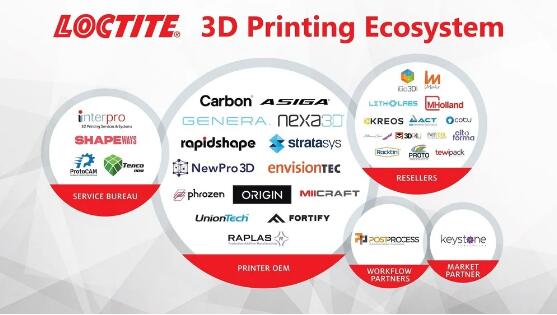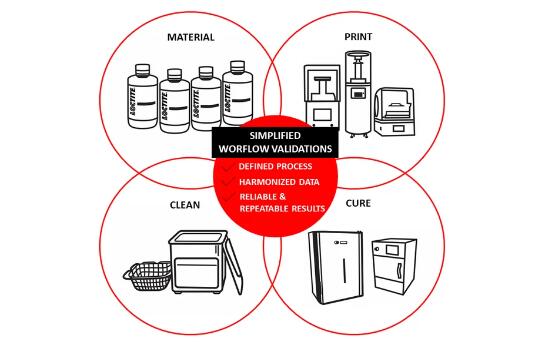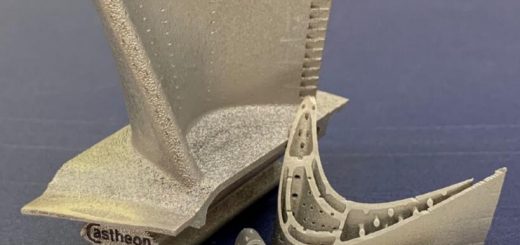Henkel’s Expands AM Ecosystem and Commitment to Workflow Validation
Additive manufacturing has had a profound impact on prototyping, but what about the final product? At what point does it make sense for a company to adopt 3D printing for end-use parts? Who provides the tools and what new processes are required? Can one vendor do it all, or does a scalable solution require the cooperation and coordination of multiple suppliers?
These are the questions many businesses are asking as they plan for digital transformation. For Henkel and its ecosystem of partners, collaboration and workflow validation provide many of the answers.

![]() Henkel’s Ecosystem
Henkel’s Ecosystem
A little over two years ago, Henkel launched its Open Materials Platform to facilitate collaboration with key players in photopolymer 3D printing. Working closely with original equipment manufacturers (OEMs), end-users and others, Henkel’s goal was to help additive manufacturing go beyond prototyping by developing materials and applications that would thrive in a production environment.
Since then, Henkel has built an ecosystem alongside many of the industry’s most renowned brands. Henkel is collaborating with many different equipment manufacturers including Carbon, Nexa3D, RapidShape, Asiga, NewPro3D, Genera, and Phrozen. Other collaborators include EnvisionTec – which was recently acquired by Desktop Metal – and Origin – which was acquired by Stratasys.
Beyond the OEM, Henkel has also developed a global network of distributors including Proto Products, Act 3D, and MHolland in the United States; Rocktin in Canada and Asia; LithoLabs, Hillmann & Geitz and tewipack in Germany; and cotu, cito forma, Kreos, 3DP4U, and Partool in other parts of Europe. To support requests for parts from customers, Henkel has partnered with Tenco DDM in Europe and several US-based service bureaus, including Shapeways, InterPro3D, and ProtoCAM.
“Our goal with the Open Materials Platform is to collaborate with partners across 3D printing’s value chain so customers have the widest range of options to meet their manufacturing needs,” says Sam Bail, Global Sales Manager, 3D Printing at Henkel. “Equipment OEM’s, Software Co’s, specialty distribution, engineering & design firms, and service bureaus all make important contributions in helping customers realize the potential of their investments in additive. Loctite 3D Materials are globally produced at scale allowing us to work with partners around the world.”
![]() Workflow Validation
Workflow Validation

As a global manufacturing company, Henkel understands the importance of an efficient workflow. In a production environment, machines, materials, software, people and processes must all work symbiotically. With its entry in the 3D printing market, Henkel has been focused on sharing this expertise, helping customers develop and validate workflows that enable consistency and repeatability.
Henkel offers a wide portfolio of photopolymer resins for 3D printing and each offers unique characteristics that are ideal for specific applications. Some offer extreme toughness, durability and impact resistance, while others provide elastomeric properties, making them flexible and highly resilient. Beyond the basics, Henkel also offers niche products such as a transparent material, and several that offer high heat resistance, including one that is fire, smoke and toxicity (FST) rated.
Henkel’s resin-based materials are ideally suited for DLP, CLIP and other cutting-edge technologies. Even though there are similarities between these processes, each device has unique characteristics. To achieve optimal results and repeatably in a given application, a workflow must be developed that is specific to the machine and material.
Henkel works closely with its partners to validate materials and provide detailed instructions on how the parts should be printed and processed. Using Henkel’s web-based tools, customers can quickly see which materials have been validated for a given machine, and after choosing from a few basic options, download complete specifications for printing, curing, and cleaning their parts.
![]() Ecosystem in Action
Ecosystem in Action
Certain applications require even deeper collaboration. For example, Litholabs has been working with ERNI, a Switzerland-based electronics connector manufacturer, on improving the functional prototyping of connectors for printed circuit boards (PCBs). By combining Asiga’s high accuracy 3D printing technology with Loctite 3D 3955 FST material, Litholabs and ERNI were able to design prototypes that offered the fine surface detail needed for small, intricately designed electronics components.
Working directly with Henkel, they also confirmed that the parts met the requirement for heat resistance. Beyond connectors, the team also discovered that they could prototype entire PCB assemblies, allowing them to optimize the design and achieve customer acceptance more quickly. Based on their success with prototyping, the team at ERNI is now investigating how 3D printing might allow them to move beyond rapid prototyping and into rapid manufacturing.
For companies in many industries, the quality, speed and economics of 3D printing offer a compelling value proposition. It not only allows them to produce small batches less expensively but also allows them to produce products just-in-time or even on-demand. Also, since additive manufacturing is digital, it allows customization, new design freedom, and most importantly, offers a speed-to-market advantage that other technologies can’t match.
Until recently, materials and workflow have been two of the biggest barriers preventing the adoption of additive manufacturing. To be considered for production needs, 3D printing required engineering-grade materials that offered properties on par with those used in mass manufacturing. Henkel developed its Open Materials Network with that challenge in mind.
Source: All3DP
For press release, welcome to send to 3D Science Valley at 2509957133@qq.com




Recent Comments